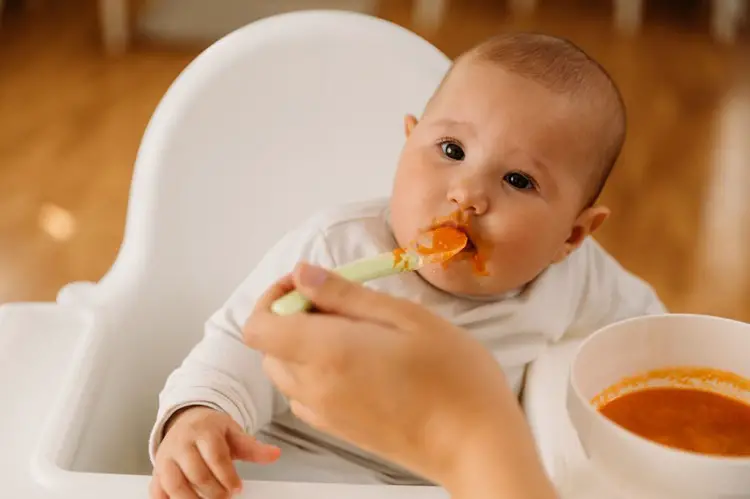Blended fruits and vegetables like carrot puree are some of the nutritious stage-one foods to feed your baby once they begin taking solid foods.
You can make carrot puree in a blender but if you don’t have one, don’t worry you can make a carrot puree by mashing steamed carrots using a potato masher.
If you’re thinking of how to make carrot puree for baby? Here are basic kitchen tools/steps to follow.
- Prepare the carrots
- Steam the carrots
- Check for doneness
- Mash the carrots with a farberware potato masher
- Cool and serve
What Are Stage-One Foods?
Baby foods are often the first solid foods given to infants as they transition from breast milk or formula.
These foods are designed to be very easy for babies to eat and digest, suitable for babies around 4 to 6 months old who are just starting their journey of getting used to solid foods.
Early baby foods are often pureed or mashed very finely to ensure they are smooth and do not pose a choking hazard.
Below are some popular foods for children in the early stages:
One-Ingredient Puree
Single-ingredient fruits like apples, pears, bananas and avocados. Or single ingredient vegetables such as carrots, sweet potatoes, peas, and squash.
Rice Cereal
Rice cereal is a popular first food for many babies. It is often mixed with breast milk or formula to create a smooth, easy-to-swallow mixture.
Oat Cereal
Oatmeal cereal is another option for introducing cereal to your baby. Like rice cereal, it can be mixed with breast milk or formula.
Oatmeal and Rice Cakes For Babies
They are often available as dry powder mixtures that you can make with breast milk or formula. They have a slightly thicker texture than liquid cereals.
One-Ingredient Meats
Some early baby foods also include single-ingredient meats such as chicken or turkey, pureed for easy consumption.
Pureed Yoghurt
Plain, full-fat yogurt is sometimes recommended for young children because it is a good source of calcium and probiotics. Make sure it is suitable for babies and does not contain added sugars.
Baby Food Jars For Stage-One
Many commercial baby food brands offer baby foods in convenient jars or bags. These can include a variety of fruits, vegetables, and grains.
Tip:
When introducing first-stage foods, it is important to start with just one ingredient and wait a few days before introducing new foods. This helps you keep an eye on any potential allergies or sensitivities.
How To Make Carrot Puree For Baby Without Blender

Making carrot puree for your baby without a blender is still quite simple, and can be done with a few alternative methods. Here’s a simple kitchen method:
Ingredients:
- 2-3 carrots (peeled and cut into small pieces)
- Water
- A jar with a lid
- A fork or potato masher
What Kind of Carrots to Use
I recommend peeling organic whole carrots before chopping and cooking them.
I know it’s an extra step, but I recommend peeling them to remove dirt particles and/or pesticide residue.
It also tastes better when you peel the carrots, they taste super earthy when they have the peel on. You can also use baby carrots, which are already peeled, so the chopping process is faster.
Instructions
1. Prepare Carrots
Peel and cut the carrots into small pieces of equal size. The smaller the carrot pieces are, the faster they cook.
2. Steam Carrots
Place chopped carrots in a pot with a tight-fitting lid. Add enough water to cover the bottom of the pan by about ½ an inch.
Cover the pot and bring the water to boil over medium-high heat. Once boiling, reduce heat to low and let carrots steam for about 15 to 20 minutes or until tender when pierced with a fork.
3. Check For Doneness
To check if the carrots are done, pierce a piece with a fork. It will slide easily over the carrot. If the carrots are still too hard, continue steaming for a few more minutes.
4. Mash the Carrots
Once the carrots are soft, remove them from the heat and drain off excess water.
Next, use a fork or potato masher like the Farberware 5211438 Professional Heat Resistant Nylon Meat and Potato Masher to mash the cooked carrots.
This product is easy to use, safe, and also heat-resistant. >>CLICK HERE<< to check for its best prices on Amazon.
You can mash them until you reach your desired consistency. For younger children, a thicker texture may be appropriate.
5. Cool and Serve
Let the pureed carrots cool before feeding your baby. Make sure it’s not too hot and always check the temperature before providing it.
6. Storing or Serving
You can use the puree carrots immediately or store them in a BPA-free storage container in the refrigerator for up to 3 days. You can also freeze it in an ice tray for longer storage.
I use silicone ice cube trays and 4 oz glass storage containers. The ice cube trays are great for babies who aren’t eating as much volume since they can defrost one cube at a time.
For older babies who eat more than 1 oz at a time, the 4 oz jars are best.
Healthy Benefits of Carrots on Infants
Carrots are a very nutritious first food since they contain beta-carotene, an antioxidant, which is converted into vitamin A in the body.
In addition to vitamin A, carrots also contain vitamin C, iron, calcium, and fiber, which can help with normal bowel movements in babies.
Carrot Baby Food Recipes
Besides serving carrot puree alone, you can mix it with a wide variety of foods.
Here are some of my favorite carrot puree recipes:
- Other Sweet Vegetables: Add pumpkin, sweet potatoes, summer squash, or butternut squash to this first baby food.
- Green Veggies: You can mix carrot puree with spinach, green beans, peas, cauliflower, or broccoli puree to moderate the robust flavor of some green vegetables that your baby might not like.
- Creamy Foods: You can make this healthy baby food recipe with whole milk yogurt, breast milk, or organic baby formula.
- Whole Grains: All cooked grains such as oatmeal, quinoa, brown rice (or any variety of cooked rice), barley, and others would be a delightful addition to this homemade stage 1 baby food. The grains can be either pureed or left soft and cooked to create a more textured puree.
- Fresh Fruits: Combine carrot puree with banana puree, apples, pears, peaches, prunes, or mango puree for a great starter puree!
- Protein: To enhance the nutritional value of the meal, consider incorporating protein-rich ingredients. Options such as tofu, lentils, white beans, or even chicken or beef, if vegetarian restrictions are not a concern, can be added to this baby food carrot recipe.
How To Feed Your Baby Carrots

There are several methods available for introducing carrots to your infant.
You have the option of personally feeding them, allowing them to independently explore, or employing a combination of both approaches.
The following guidelines outline how to introduce carrots to your baby:
1. Spoon-Feeding
This method is the most commonly used for introducing purees to infants.
Simply spoon a small quantity of carrot baby food into your baby’s mouth and encourage them to swallow.
Continue feeding as long as they are actively opening their mouth and leaning forward to consume the food.
You will be able to discern that they have finished when they either turn their head or push the food away.
2. Finger Foods
This approach aligns with the baby-led weaning philosophy. Offer your baby large, soft pieces of carrots on a tray and allow them to explore the food independently.
3. Combination
During the transition phase to self-feeding, I would initially spoon-feed my children and subsequently provide them with chunkier foods to consume on their own using their hands and a spoon.
Can I Mix Carrot Puree With the Formula?
Yes, you can mix pureed carrots with formula if you want to create a smoother, thicker meal for your baby.
Mixing pureed vegetables with formula or breastmilk is a common way to introduce solid foods to infants, especially when they are in the early stages of transitioning to solid foods.
Here’s how:
Prepare Carrot Puree
Prepare the carrot puree following the above-listed steps.
Let The Puree Cool
Make sure the carrot puree has cooled to a safe temperature before mixing it into the formula.
Measure the Formula
Measure the desired amount of formula you want to mix into the carrot puree. You can start with a small amount and adjust it according to your baby’s preferences and dietary needs.
Mix Carefully
Mix the measured formula and pureed carrots in a bowl or container. Mix or whisk them together until you get your desired consistency.
You can make it thin or thick depending on what you think the baby can hold comfortably.
Check Temperature
Always check the temperature of the mixture to make sure it’s not too hot before giving it to your baby. The temperature must be warm or at a safe temperature for your baby.
Serve
Use a spoon to feed your baby a mixture of pureed carrots and formula and observe your baby’s reaction.
Related Posts:
How to Reheat or Thaw Your Frozen Carrot Puree
To defrost frozen pureed carrots, it is recommended to remove the jar from the freezer the night before use and allow it to thaw in the refrigerator overnight.
Alternatively, a water bath may be used for immediate use.
While some may suggest microwaving the frozen puree using the defrost setting, the following two methods are preferred:
Refrigerator Defrost
Place frozen puree cubes into a jar or baby’s serving dish, cover, and refrigerate overnight. If the puree was stored in a jar or storage container, simply place the container in the fridge.
Water Bath
Place frozen pureed cubes in a small container and set it in a larger container with warm water.
Replace the water as needed. Once defrosted, share the food into individual bowls, cover, and refrigerate until it is time to serve. It is important to use defrosted food within 48 hours and not refreeze it.
FAQs
Are Pureed Carrots Healthy?
Yes, pureed carrots are a healthy food choice for both babies and adults. Carrots are rich in essential nutrients and offer several health benefits.
Is carrot puree healthy for babies?
Yes. Carrot puree is a healthy and nutritious choice for babies, especially when they are starting to transition to solid foods.
When do I give baby carrots?
Carrots are considered to be among the most suitable initial food options for infants. The introduction of carrots to your baby’s diet can commence as early as 4 months, although it is generally recommended to initiate solid foods around the age of 6 months.
Carrots serve as an excellent stage 1 food for your baby due to their abundant vitamin and mineral content, as well as their mild and enjoyable taste. Furthermore, carrots pose a low risk in terms of allergenicity, making them a safe choice for early introduction.
Can I mix carrot puree with infant formula?
Yes, you can mix carrot puree with infant formula if you’d like to create a smoother and more liquid consistency for your baby’s meal.
Mixing pureed vegetables, like carrot puree, with formula is a common practice when introducing solid foods to infants, especially if they are in the early stages of transitioning to solid foods.
Conclusion
Using a potato masher or fork to mash steamed carrots is another way to prepare a smooth puree for your baby.
If you’re worried about not having a blender and are wondering how to make carrot puree for baby without a blender, these steps will guide you through the process of getting the same result as using a blender.
